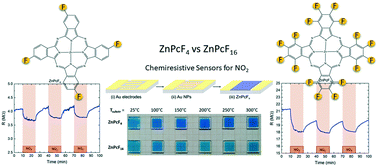Temperature-dependent phase composition of fluorinated zinc phthalocyanine thin films and their sensing properties towards gaseous NO2
Abstract
This work presents a temperature-dependent phase composition study of thin films (200 nm) of fluorinated zinc phthalocyanines (4F, 16F) deposited on fused silica and Si(100). The studied films were prepared using various substrate temperatures, Tsubstr, in the range between 25 °C to 300 °C. Optical absorption properties, using UV-vis spectroscopy (λ = 300–800 nm), reveal the changes in the polymorphism of the two fluorinated zinc phthalocyanine thin films over the used substrate temperature range. AFM microscopy and PXRD diffraction were used to compare the nucleation, growth, and super-structures of the thin films of ZnPcF4 and ZnPcF16. The phase transition from the triclinic α-form at low temperatures to the monoclinic β-form by increasing Tsubstr can clearly be observed by the changes of the PXRD profiles within the ZnPcF4 thin films, which is supported by the AFM measurements as well as the UV-vis transmission spectra. In addition, we prepared sets of functional textile sensors with promising sensitivity towards NO2 gas with concentration of 10.6 ppm.

- This article is part of the themed collection: Crystal Growth


 Please wait while we load your content...
Please wait while we load your content...